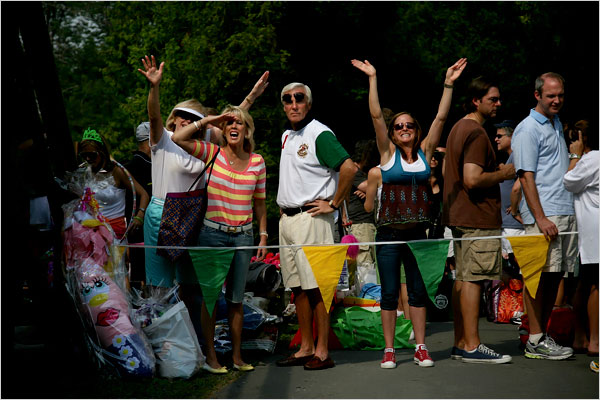Social documentary photography can occur almost by accident, especially when the subject is the middle class. This photograph from the Sunday New York Times is a case in point:
The caption reads, “Just before the official start of visiting day, parents try to get their daughters’ attention as they stand on the side, surrounded by numerous gifts that await the campers.” I like the way the photographer captures the parents as they might appear to children. (Animals at the zoo might have a similar experience.) The spectators are put on display, and despite their size they remain distant while signaling more than can be taken in. The dads appear either stern or clueless while the moms seem to be over-the-top emotional. In either case they are likely to be a load, so the gifts had better be good.
It might be more revealing yet to look at the parents from the perspective of an adult. From that perspective, doesn’t it seem that most of them look like children? Except for the grouchy old guy in the middle–we’ll get back to him later–these adults are dressed like kids. The t-shirts, shorts, tennis shoes, capri jeans, are not only casual but what kids have worn since at least the 1950s. And the adults are acting like kids, too: the girls emoting excitedly about seeing someone special, the boys waiting in line stoically to hold their place until they can make a run for the prize.
Nor does this happen only at summer camp. Look around you in the grocery store. Fathers’ and sons’ clothing would be interchangeable but for the difference in size, and lots of other people also are dressed like kids. And look at what they’re buying: some basic provisions are there, but more often than not everyone in the family has been shopping like a kid in a candy store. Bottled drinks, chips, and other treats make sure that no one is denied their version of a Popsicle. Look again at the gifts that the parents have brought with them. Like the display of wealth that it displaced, American informality goes hand in hand with a culture of consumer consumption.
I’m wearing ragged shorts and a cheap t-shirt while I’m writing this, and I wouldn’t change to go to the store or just about anywhere else in town. I’m sure that we must look like hell to anyone with any sophistication. That stern looking guy in the middle of the picture, for example. His clothing bears some of the cultural shift evident in those on either side of him, but he’s still dressed more as an adult than a child. And he has the grim expression to prove it. The guy looks like he’d rather be at a board meeting and that he evaluates everything by the standards of corporate efficiency. Visually, he’s providing the contrast needed to feature the exuberance on either side of him. Culturally, he’s a relic.
When I was growing up in the 1950s, it was a big deal for my parents’ generation to be adults. For one thing, they really hadn’t been given a choice. Equally important, adulthood came with a lot of perks: sex, money, alcohol, the vote, and other privileges made it clear that while childhood may have been fun, adulthood brought a major shift in social status. Not surprisingly, one had to look adult, and a lot of effort went into that. Consumption was a part of the deal, but the focus was primarily on being or becoming bourgeois, not on indulging oneself. One also had to act like an adult, and that’s where things started to get complicated. Gender differences became very asymmetrical gender roles; being mature meant making conformity second nature; working hard while still doing without was justified because you were doing it for the kids.
The good news is that the past fifty years have been one of continuous liberalization. The American ideal of equality has been written into law and everyday life for many people in many ways large and small. Personal liberty and American individualism has led to a richly pluralistic society where many inhibitions were overcome in the pursuit of happiness. Informality in clothing and manners became an important part of this sea-change–an enactment of liberty and equality in the performance of everyday life. False impositions of status fell away at the beach and everywhere else. The status of adulthood was one of the casualties. It no longer carried many privileges, so you might as well be comfortable.
One of the interesting side-effects of liberalization on American terms has been the prolongation of childhood. Note that one rationale for having children now is that they make you grow up. I wonder about that. But it does no good to say “grow up” if that means becoming dour or continually calculative or stupidly bourgeois. And in fact childhood is not a time of freedom from work or anxiety these days, if it ever was. When kids are being driven to prepare themselves for a life of competition, being able to act like a kid may be one of the real benefits of adulthood.
Hope has been expressed that Obama’s victory in November will lead to a fashion shift back to the higher standards of the 1940s and 1950s–first with African-American youth, who then set the tone for the rest of us. It will be interesting to see if that happens and how it plays out. Those wanting change have a case, but they also have a lot going against them, not least the belief that happiness means being forever young.
Photograph by Todd Heisler/New York Times. The related story is here.

Discussion